penmanship
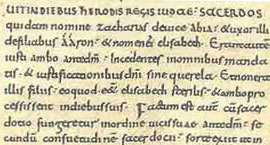
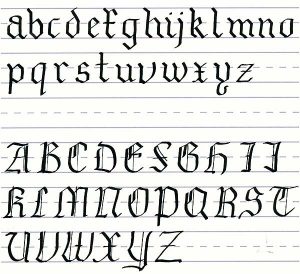 National Handwriting Day was established in 1977, and because of John Hancock’s birthday, January 23rd, and the fact that he was a signer of the Declaration of Independence, it was decided that his birthday would be the ideal day for this unique holiday. The day was started as a way to re-introduce people to the pen and paper. In a world where most writing is done by computer, and notes are in a smartphone, the idea of writing on paper has almost become strange. I think about my Uncle Bill Spencer, the genealogy patriarch of the Spencer family, and how important handwritten letters always were to him, and I can understand how this lost art was so heartbreaking for him. When I look at treasures we have found that contain the handwriting of our parents or grandparents, it definitely brings us closer to them. At least it makes us feel closer to them.
National Handwriting Day was established in 1977, and because of John Hancock’s birthday, January 23rd, and the fact that he was a signer of the Declaration of Independence, it was decided that his birthday would be the ideal day for this unique holiday. The day was started as a way to re-introduce people to the pen and paper. In a world where most writing is done by computer, and notes are in a smartphone, the idea of writing on paper has almost become strange. I think about my Uncle Bill Spencer, the genealogy patriarch of the Spencer family, and how important handwritten letters always were to him, and I can understand how this lost art was so heartbreaking for him. When I look at treasures we have found that contain the handwriting of our parents or grandparents, it definitely brings us closer to them. At least it makes us feel closer to them.
The Writing Instrument Manufacturers Association, looks at National Handwriting Day as a chance for everyone to re-explore the purity and power of handwriting. Of course, their true motive is to promote the consumption of pens, pencils, and writing paper, but that isn’t the worst thing in the world. While this holiday was invented during the 1970s, it is considered to be a holiday that is increasing in importance with the passing of each year, because the art of handwriting is gradually being lost as more and more people use computers, tablets, and phones to email, instant message, and text their thoughts. Some believe that handwriting is as unique to a person as a fingerprint. I agree, because when I look at a handwritten note from someone I know, I can usually tell you who wrote it.
The ancient Romans were the first to develop a written script for correspondence based on aspects they borrowed from the Etruscan alphabet. However, after the Roman Empire fell, the development handwriting would come to rest with various monasteries. The problem with that is that with so many styles, people couldn’t read or understand what other people wrote…until the 8th century, when Charlemagne decided to put an English monk in charge of standardizing a handwriting script. The resulting script, Carolingian minuscule, was one that featured lowercase letters and punctuation and was designed to be easily read by candlelight. And it was a script that was highly used up until the 15th century.
During the 15th century, Johannes Gutenberg came up with a denser style of writing script for use on printed parchments and in books. This Gothic script was used extensively on his printing press, but was not really very popular with the people. Finally, Italian humanists decided to go back to a Carolingian script and then invented a cursive form of it that would eventually become known as italic. From that point on, penmanship was seen as a symbol of status. The schools began education young scholars in its use during the 18th century. The mid-19th century in the United States, brought a cursive writing system developed by my 3rd cousin 5 times removed, Platt Rogers Spencer. His penmanship style became known as the Spencerian Method. It was widely taught and many schools quickly adopted its use, but it was eventually replaced by the Palmer Method, invented by Austin Norman Palmer, at the turn of the century. The Palmer Method would eventually be replaced by the D’Nealian script, invented by Donald Thurber. It was introduced into American schools in the late 1970s.
Unfortunately, handwriting began to decline during the 1980s. Typewriters and word processors were used for writing instead of a pen and paper. We all thought it was the wave of the future, and the advance of the technological age, but I wonder if we somehow missed the bigger picture. Schools began to eliminate handwriting courses, replacing them with typewriting and eventually computer classes, and the art of 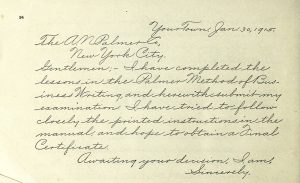
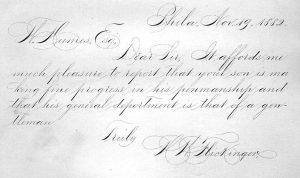 handwriting got lost in the excitement of something new. Now, it is in serious danger of disappearing altogether. As I contemplate the end of such an important part of history, and think of my Uncle Bill, and his understanding of its real importance, I realize just how big that loss really is.
handwriting got lost in the excitement of something new. Now, it is in serious danger of disappearing altogether. As I contemplate the end of such an important part of history, and think of my Uncle Bill, and his understanding of its real importance, I realize just how big that loss really is.
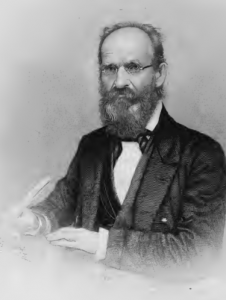 Platt Rogers Spencer, who is my 3rd cousin 5 times removed, was a social activist. In other words, he saw something that was socially or morally wrong, such as slavery, and he actively fought against it. These days that would mean protesting, lobbying, and blogging against it. Social activism has it’s place, but should be done in the proper way. Platt Spencer was a zealous promoter of the antislavery movement…an honorable cause. He was a prominent advocate of the abstinence movements. He was instrumental in founding business colleges in the United States, and was in organizing several business colleges in the United States, and he was an instructor in business colleges throughout the country.
Platt Rogers Spencer, who is my 3rd cousin 5 times removed, was a social activist. In other words, he saw something that was socially or morally wrong, such as slavery, and he actively fought against it. These days that would mean protesting, lobbying, and blogging against it. Social activism has it’s place, but should be done in the proper way. Platt Spencer was a zealous promoter of the antislavery movement…an honorable cause. He was a prominent advocate of the abstinence movements. He was instrumental in founding business colleges in the United States, and was in organizing several business colleges in the United States, and he was an instructor in business colleges throughout the country.
In 1815, Spencer taught his first writing class, and in New York, where he founded the Spencer Seminary in Jericho, housed in a log cabin. From 1816 to 1821, he was a clerk and a book keeper and, from 1821 to 1824, he studied in law, Latin, English literature and penmanship. He also taught in a common school and wrote up merchants’ books. 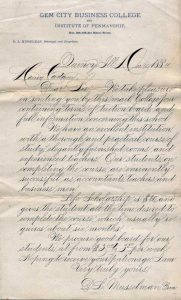 In 1824, he contemplated entering college with a view to preparing for the ministry, but, due to his alcoholism, which was aggravated by the prevalent drinking customs of the time, he did not. He struggled with alcoholism for a number of years. He then taught in Ohio, where in 1832, he was able to withdraw from alcohol completely, becoming a total abstainer. He advocated abstaining from alcohol for the remainder of his life. Soon after his recovery from alcoholism, he was elected to public office, as county treasurer of Ashtabula County, Ohio for twelve years. He also was a founding member of the Ashtabula County Historical Society established in 1838 and he was instrumental in collecting the early history of Ashtabula County, Ohio.
In 1824, he contemplated entering college with a view to preparing for the ministry, but, due to his alcoholism, which was aggravated by the prevalent drinking customs of the time, he did not. He struggled with alcoholism for a number of years. He then taught in Ohio, where in 1832, he was able to withdraw from alcohol completely, becoming a total abstainer. He advocated abstaining from alcohol for the remainder of his life. Soon after his recovery from alcoholism, he was elected to public office, as county treasurer of Ashtabula County, Ohio for twelve years. He also was a founding member of the Ashtabula County Historical Society established in 1838 and he was instrumental in collecting the early history of Ashtabula County, Ohio.
In 1840, Platt developed a beautiful and unique style of writing and named it after himself, calling it Spencerian Script. The penmanship style quickly became the standard in the United States from 1850 to 1925. It was considered the American de facto standard writing style for business correspondence prior to the widespread adoption of the typewriter. Platt used various existing styles as the inspiration for his unique oval-based style. His style could be written quickly and legibly and yet it still looked elegant, which made it perfect for business 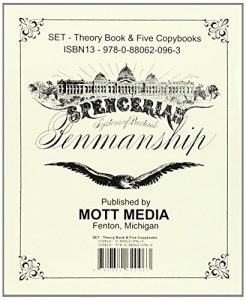 correspondence, as well as personal letters. Immediately following his development of the Spencerian Script style, Platt began teaching it in the schools he established for the purpose of teaching his penmanship style. As soon as his students began to graduate, they started replicas of the Spencerian Script abroad, and then in 1850 it reached the common schools. Unfortunately, Platt Spencer never got to see the full success of his unique penmanship, because he died on May 16, 1864. Nevertheless, his sons made it their mission to bring their late father’s dream to fruition. They accomplished that feat by distributing Spencer’s previously unpublished book, Spencerian Key to Practical Penmanship, in 1866. Spencerian Script was gradually replaced in primary schools with the simpler Palmer Method developed by Austin Norman Palmer…which is sadly very plain by comparison. The Coca-Cola Company famously used Spencerian Script in its now famous logo, and continues to do so to this day.
correspondence, as well as personal letters. Immediately following his development of the Spencerian Script style, Platt began teaching it in the schools he established for the purpose of teaching his penmanship style. As soon as his students began to graduate, they started replicas of the Spencerian Script abroad, and then in 1850 it reached the common schools. Unfortunately, Platt Spencer never got to see the full success of his unique penmanship, because he died on May 16, 1864. Nevertheless, his sons made it their mission to bring their late father’s dream to fruition. They accomplished that feat by distributing Spencer’s previously unpublished book, Spencerian Key to Practical Penmanship, in 1866. Spencerian Script was gradually replaced in primary schools with the simpler Palmer Method developed by Austin Norman Palmer…which is sadly very plain by comparison. The Coca-Cola Company famously used Spencerian Script in its now famous logo, and continues to do so to this day.

